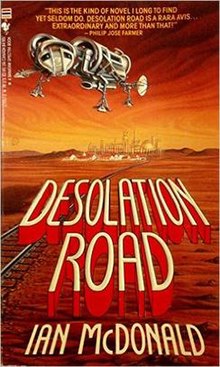
Mars, the fourth planet from the Sun, has appeared as a setting in works of fiction since at least the mid-1600s. Trends in the planet's portrayal have largely been influenced by advances in planetary science. It became the most popular celestial object in fiction in the late 1800s as the Moon was evidently lifeless. At the time, the predominant genre depicting Mars was utopian fiction. Contemporaneously, the mistaken belief that there are canals on Mars emerged and made its way into fiction, popularized by Percival Lowell's speculations of an ancient civilization having constructed them. The War of the Worlds, H. G. Wells' story of an alien invasion of Earth by sinister Martians, was published in 1897 and went on to have a large influence on the science fiction genre.
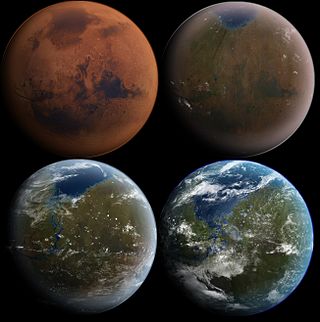
Terraforming or terraformation ("Earth-shaping") is the hypothetical process of deliberately modifying the atmosphere, temperature, surface topography or ecology of a planet, moon, or other body to be similar to the environment of Earth to make it habitable for humans to live on.
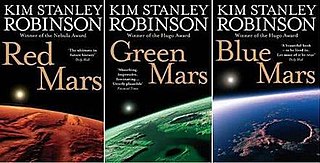
The Mars trilogy is a series of science fiction novels by Kim Stanley Robinson that chronicles the settlement and terraforming of the planet Mars through the personal and detailed viewpoints of a wide variety of characters spanning almost two centuries. Ultimately more utopian than dystopian, the story focuses on egalitarian, sociological, and scientific advances made on Mars, while Earth suffers from overpopulation and ecological disaster.
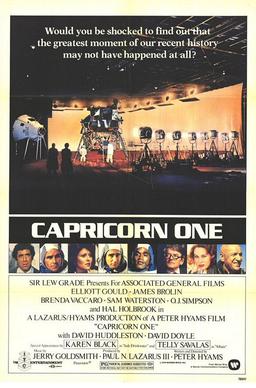
Capricorn One is a 1978 British-produced American thriller film in which a reporter discovers that a supposed Mars landing by a crewed mission to the planet has been faked via a conspiracy involving the government and—under duress—the crew themselves. It was written and directed by Peter Hyams and produced by Lew Grade's ITC Entertainment. It stars Elliott Gould as the reporter, and James Brolin, Sam Waterston, and O. J. Simpson as the astronauts. Hal Holbrook plays a senior NASA official who goes along with governmental and corporate interests and helps to fake the mission.

Arrakis —informally known as Dune and later called Rakis—is a fictional desert planet featured in the Dune series of novels by Frank Herbert. Herbert's first novel in the series, 1965's Dune, is considered one of the greatest science fiction novels of all time, and it is sometimes cited as the best-selling science fiction novel in history.
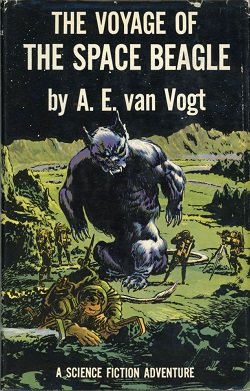
The Voyage of the Space Beagle (1950) is a science fiction novel by Canadian-American writer A. E. van Vogt. An example of space opera subgenre, the novel is a "fix-up" compilation of four previously published stories:
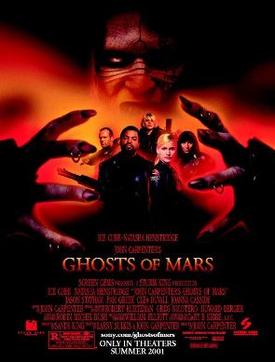
Ghosts of Mars is a 2001 American science fiction action horror film written, directed and scored by John Carpenter. It was produced by Screen Gems and distributed by Sony Pictures Releasing. The film stars Natasha Henstridge, Ice Cube, Jason Statham, Pam Grier, Clea DuVall, and Joanna Cassidy. Set on a colonized Mars in the 22nd century, the film follows a squad of police officers and a convicted criminal who fight against the residents of a mining colony who have been possessed by the ghosts of the planet's original inhabitants.

Ian McDonald is a British science fiction novelist, living in Belfast. His themes include nanotechnology, postcyberpunk settings, and the impact of rapid social and technological change on non-Western societies.

The planet Venus has been used as a setting in fiction since before the 19th century. Its impenetrable cloud cover gave science fiction writers free rein to speculate on conditions at its surface; the planet was often depicted as warmer than Earth but still habitable by humans. Depictions of Venus as a lush, verdant paradise, an oceanic planet, or fetid swampland, often inhabited by dinosaur-like beasts or other monsters, became common in early pulp science fiction, particularly between the 1930s and 1950s. Some other stories portrayed it as a desert, or invented more exotic settings. The absence of a common vision resulted in Venus not developing a coherent fictional mythology, in contrast to the image of Mars in fiction.
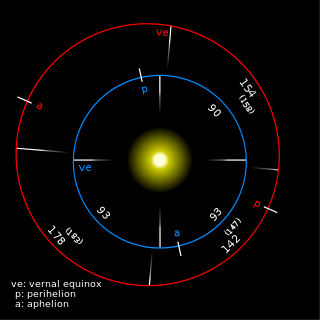
Though no standard exists, numerous calendars and other timekeeping approaches have been proposed for the planet Mars. The most commonly seen in the scientific literature denotes the time of year as the number of degrees on its orbit from the northern vernal equinox, and increasingly there is use of numbering the Martian years beginning at the equinox that occurred April 11, 1955.

A desert island, deserted island, or uninhabited island, is an island, islet or atoll that is not permanently populated by humans. Uninhabited islands are often depicted in films or stories about shipwrecked people, and are also used as stereotypes for the idea of "paradise". Some uninhabited islands are protected as nature reserves, and some are privately owned. Devon Island in Canada's far north is the largest uninhabited island in the world.
Terraforming is well represented in contemporary literature, usually in the form of science fiction, as well as in popular culture. While many stories involving interstellar travel feature planets already suited to habitation by humans and supporting their own indigenous life, some authors prefer to address the unlikeliness of such a concept by instead detailing the means by which humans have converted inhospitable worlds to ones capable of supporting life through artificial means.

The terraforming of Mars or the terraformation of Mars is a hypothetical procedure that would consist of a planetary engineering project or concurrent projects, with the goal to transform Mars from a planet hostile to terrestrial life to one that can sustainably host humans and other lifeforms free of protection or mediation. The process would involve the modification of the planet's extant climate, atmosphere, and surface through a variety of resource-intensive initiatives, and the installation of a novel ecological system or systems.

Dr. Futurity is a 1960 science fiction novel by American writer Philip K. Dick. It is an expansion of his earlier short story "Time Pawn", which first saw publication in the summer 1954 issue of Thrilling Wonder Stories. Dr. Futurity was first published as a novel by Ace Books as one half of Ace Double D-421, bound dos-à-dos with John Brunner's Slavers of Space.

The Tales of the Late Ivan Petrovich Belkin is a series of five short stories and a fictional editorial introduction by Russian author Aleksandr Pushkin. The collection is opened with the editorial, in which Pushkin pretends to be the verbose publisher of Belkin's tales. The tales themselves are not related to one another, except that they are all said in the introduction to be stories told by various people to a recently deceased landowner, Ivan Petrovich Belkin. The introduction continues to say that Belkin was an interesting and mysterious man, even to the point that the woman he left his estate to had never met him. It is also mentioned that Belkin's favorite pastime was to collect and hear stories, several of which are to be presented to the reader.

Barsoom is a fictional representation of the planet Mars created by American pulp fiction author Edgar Rice Burroughs. The first Barsoom tale was serialized as Under the Moons of Mars in 1912 and published as a novel as A Princess of Mars in 1917. Ten sequels followed over the next three decades, further extending his vision of Barsoom and adding other characters.

The Martian is a 2011 science fiction debut novel written by Andy Weir. The book was originally self-published on Weir's blog, in a serialized format. In 2014, the book was re-released after Crown Publishing Group purchased the exclusive publishing rights. The story follows an American astronaut, Mark Watney, as he becomes stranded alone on Mars in 2035 and must improvise in order to survive.

The Martian is a 2015 science fiction film directed by Ridley Scott and starring Matt Damon. Drew Goddard adapted the screenplay from the 2011 novel The Martian by Andy Weir. The film depicts an astronaut's lone struggle to survive on Mars after being left behind and the efforts of NASA to rescue him and bring him home to Earth. It also stars Jessica Chastain, Jeff Daniels, Kristen Wiig, Chiwetel Ejiofor, Sean Bean, Michael Peña, Kate Mara, Sebastian Stan, Aksel Hennie, Mackenzie Davis, Donald Glover, and Benedict Wong.

Paper Towns is a 2015 American romantic mystery comedy-drama film, directed by Jake Schreier, based on the 2008 novel of the same name by John Green. The film was adapted for the screen by Scott Neustadter and Michael H. Weber, the same team that wrote the first film adaption of another of Green's novels, The Fault in Our Stars. The film stars Nat Wolff and Cara Delevingne and was released on July 24, 2015, in the United States by 20th Century Fox. The film follows the coming of age and search by the protagonist, Quentin "Q" Jacobsen (Wolff), for Margo Roth Spiegelman (Delevingne), his childhood friend and object of affection. In the process, Quentin explores the relationship with his friends including his compatibility with Margo.
List of works by or about the British author Ian McDonald.
